
In early fall, I give my chickens the run of the our vegetable and herb garden. This bantam mottled cochin enjoys the diversity of plants and insect foods.
Chickens can be tightly confined and still produce a lot of eggs, but productivity is not necessarily a measure of contentment. Have you ever wondered how chickens would live if they could choose? I think the best place to look for an answer is in Asia, where their wild relatives evolved. Genetic studies suggest that chickens were domesticated largely from red jungle fowl, so we can use information about red jungle fowl habitats and habits as guidance in creating an environment that will best allow chickens to express their natural behaviors. I will address some common questions about chickens, using what is known about red jungle fowl.
What is a “normal” flock size?
Aside from the smallest of backyard flocks, most domestic chickens are kept in large groups. But according to a study in India, flocks of red jungle fowl are actually quite small.
- When not breeding, this bird lives in small groups, typically consisting of 1 rooster with 1-4 hens, and sometimes with 1 or 2 subordinate roosters trailing in close proximity.
- Most younger males live in single sex groups of 2-4.
- In spring, breeding hens go off to nest singly. Once a hen is done laying her clutch of 3-7 eggs, she incubates the eggs, then raises her chicks on her own. Hens are not usually associated with a flock while raising chicks.
Frankly, I was surprised to learn that their flocks are so small. When I was planning for my flock, I was told I needed at least 6 birds to satisfy their social needs. But that idea is apparently unfounded.
How much space do chickens need?
A study in India showed that a flock of about 5 red jungle fowl occupies, on average, an area of 12.5 acres. That’s a population density of only 1 bird for every 2.5 acres! Compare that to the oft quoted standard of a minimum of 4-10 square feet per chicken in captivity!! Chickens spread themselves out quite thinly, given the opportunity.
What’s a normal activity level for a chicken?
I’ve often read that captive animals don’t need or want to move about, as long as they are given all the food and water they need. They’re “fat and happy”, we are told. But my birds have unlimited food and water available at all times, and still explode out the door as soon as I open it. And that is no surprise, considering the normal daily routine of wild red jungle fowl:
- About 5 hours of active foraging in the morning, beginning with a drink at the water hole.
- Resting and dust bathing in the shade and safety of dense vegetation during the afternoon heat.
- An additional 2-3 hours of active foraging in early evening as they make their way towards the water hole for another drink, before returning to their roost for the night.
That’s a total of 7-8 hours of active foraging per day!
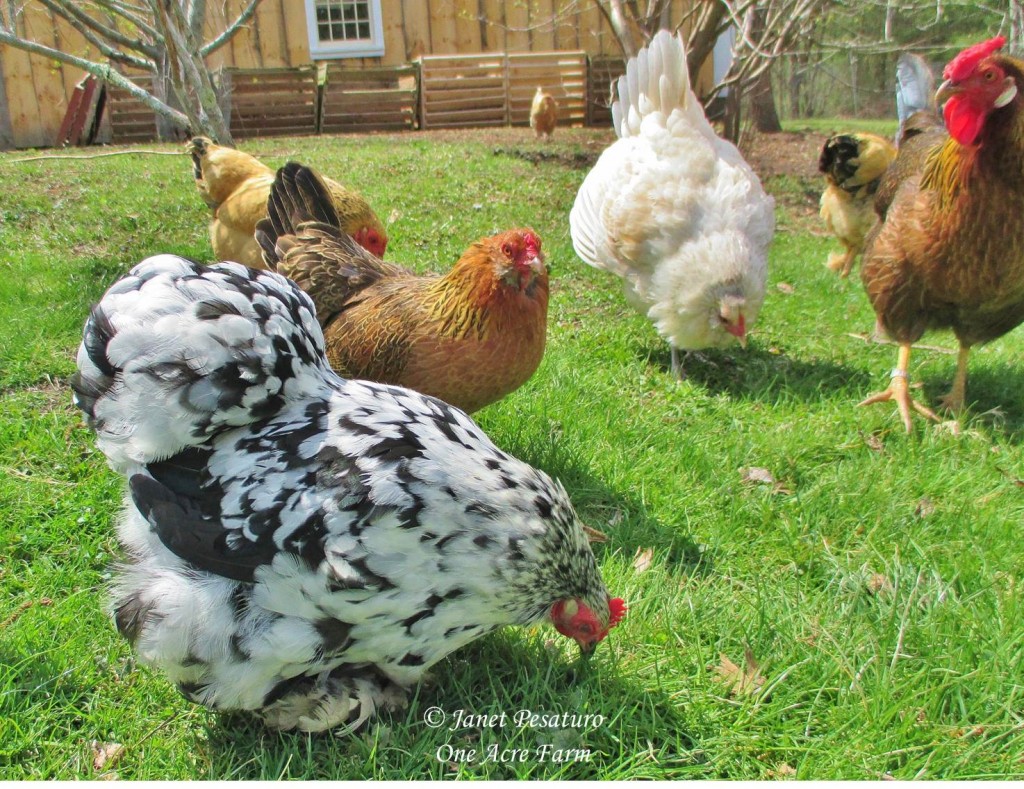
This flock of chickens ranging over lawn is a pretty site, but chickens prefer taller and more diverse vegetation.
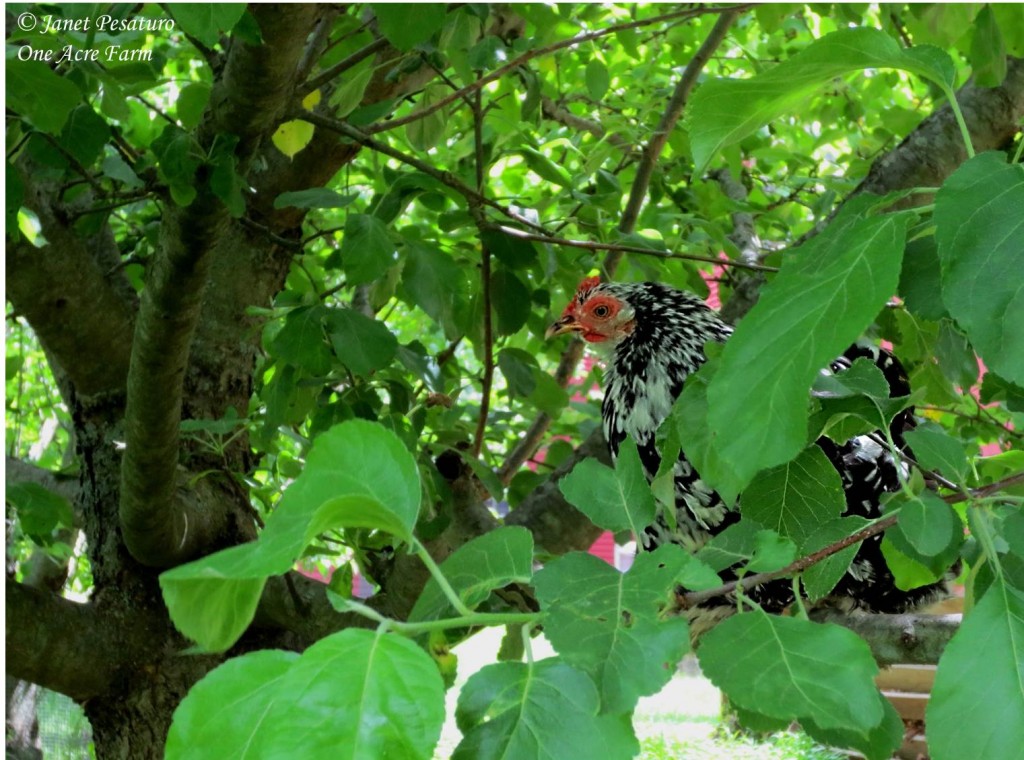
Chickens love the cover provided by trees and shrubs. Mine like to rest on the ground beneath, and to perch in the lower branches of our apple trees.
What kind of habitat do chickens prefer?
Who doesn’t associate chickens with open lawns and bucolic pastures? But their free and wild relatives frequent a variety of habitats, all with better cover and plant diversity, than lawn or pasture. Red jungle fowl in India prefer:
- “Second growth” (young) forest
- Forest edges (where forest and field meet)
- Scrubby/shrubby areas
- Bamboo forests
- Patches of tall bunchgrass for nesting, because the tall, spreading leaves provide good cover for chicks, and open areas in between clumps which allow young chicks to move easily.
- Cultivated fields, where they partake of crops.
They move among these different habitats to harvest favorite foods as they become available. So, for example, when coveted berries are in season in scrub land, the birds will spend more time there.
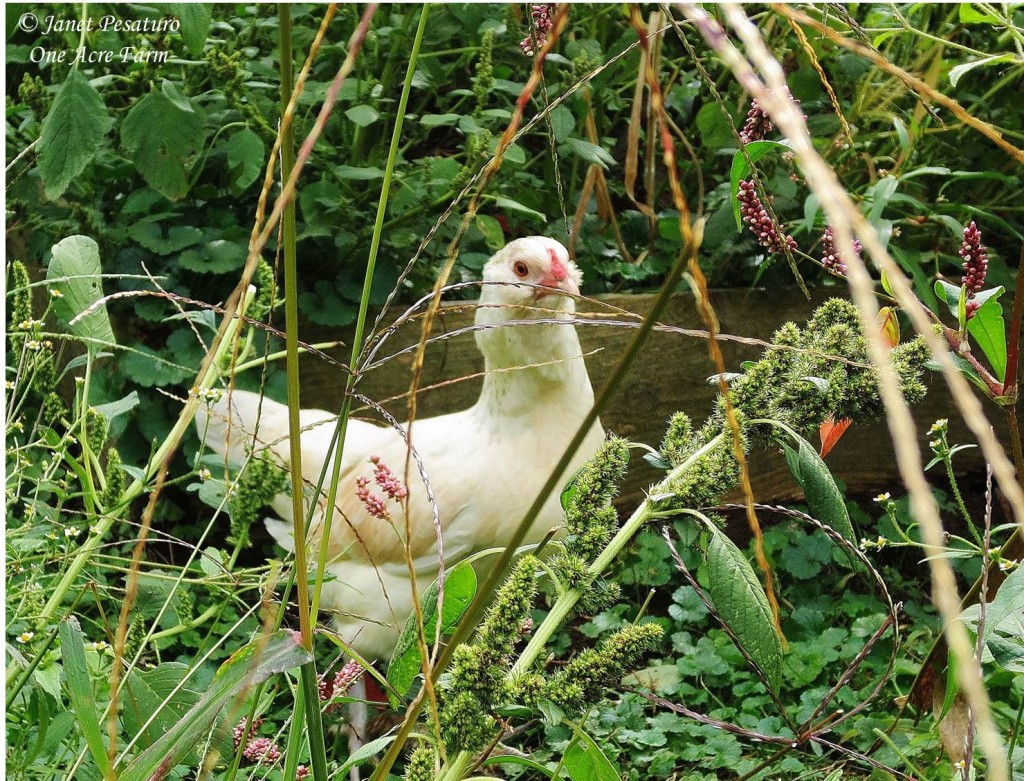
Chickens prefer overgrown weedy fields to manicured lawn, because the former offers a much greater diversity of plant and insect foods. Take this into consideration when creating a chicken habitat.
What do chickens like to eat?
Chickens use a variety of habitats precisely because they like to eat a wide variety of foods. Red jungle fowl crop studies reveal an enormously varied diet:
- Seeds from about 30 different species of plants (some seeds were probably ingested for the fruit)
- A wide variety of grasses, young bamboo shoots, leaves, and flower petals
- Many kinds of insects, spiders, snails, caterpillars, worms, and lizards
- Termites are thought to be particularly important protein source for young chicks.
So what’s the take home message about creating a chicken habitat?
- Small flock size is better than large.
- More space is always better than less.
- Higher plant diversity – trees, shrubs, herbaceous plants, and grasses – is preferable, because chickens eat so many different plant food
- Higher plant diversity also attracts a wider variety of insect/invertebrate prey.
- Chickens enjoy eating the seeds of grasses and weeds, not just the green leaves, so a patch that can go to seed, is better than mowed lawn.
- Chickens enjoy the security under the cover of tall or dense vegetation.
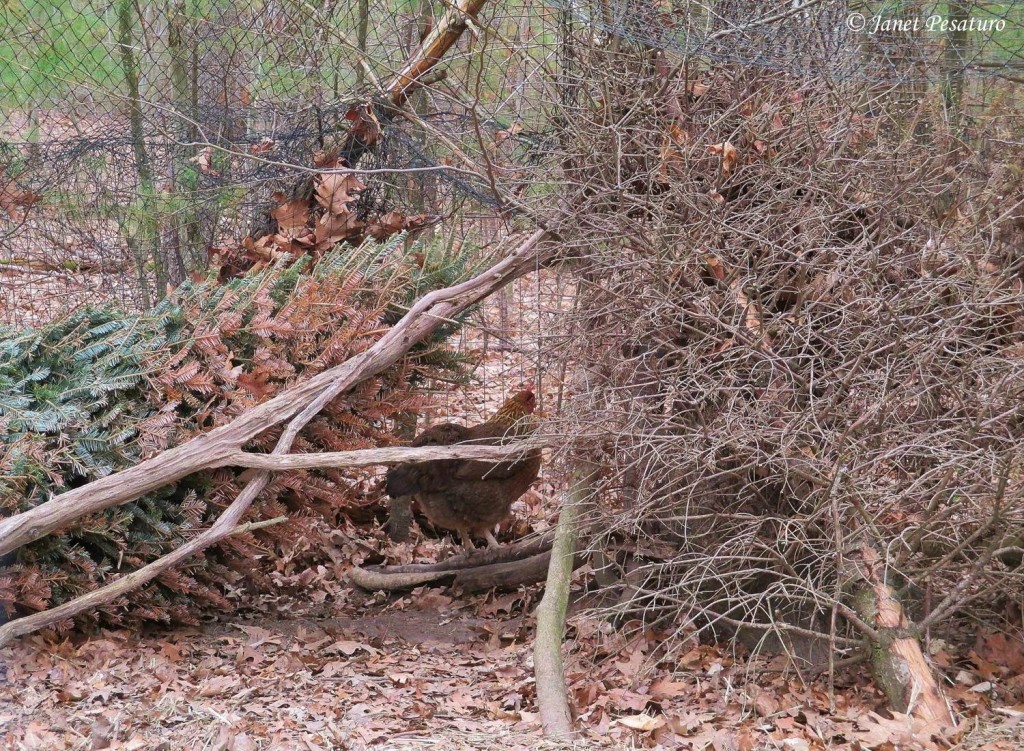
Chickens confined within a relatively small space will devastate most plantings. So, to provide cover, my good friend Reta made this hiding area with discarded Christmas trees and fallen branches. Her chickens also like to perch on the branches.
How to make the most of your available space
Chickens confined at high density will quickly destroy most plant life. So if you cannot provide plant diversity, try adding complexity and diversions. Here are some ideas.
- Bring them berry laden branches when in season (I bring branches of wild autumn olive and elderberry into the chicken yard in late summer, and chickens love plucking the berries)
- Keep your compost bin within the chicken yard or run. Turn it frequently to prevent rodents from making their homes in it.
- Feed them mealworms, especially if they have little access to insects. Dried mealworms are a convenient treat. Or, you can raise mealworms and treat your chickens to live ones.
- Provide a dust bathing area (sand/soil in a litter box will work).
- Discarded Christmas trees and fallen branches can provide additional shade, cover, and perches. They enjoy the hiding places even if their set-up is predator proof.
- Create an interesting playground of perches, using boards and/or fallen branches.
- Hang a head of cabbage and a basket of other leafy greens for them to peck at.
- In winter, a basket of birdseed-studded suet can be a great diversion and treat.
Sources:
- Collias, N. E. and Collias, E. C. A Field Study of the Red Jungle Fowl in North-Central India. The Condor, 69: 360-368, 1967.
- Collias, N. E. and Saichuae, P. Ecology of the Red Jungle Fowl in Thailand and Malaya with Reference to the Origin of Domestication. Nat. Hist. Bull. Siam Soc. 189-200, 1967
- Johnson, R.A. Habitat Preference and Behavior of Breeding Jungle Fowl in Central Western Thailand. Wilson Bull, 270-272, 1963.
- Sawai, H. et al. The Origin and Genetic Variation of Domestic Chickens with Special Reference to Junglefowls Gallus g. gallus and G. varius. PloS one, 2010.
- Red Jungle Fowl Fact File
Shared on: Homestead Barn Hop #158, Heritage Homesteaders Hop #10, Thank Goodness it’s Monday #69, Backyard Farming Connection #79, Down Home Blog Hop #86, HomeAcre Hop #69, Wildcrafting Wednesday #136, From the Farm Blog Hop, Simply Natural Saturdays, Mountain Woman Rendezvous #45, Simple Life Sunday #17, Natural Living Monday, Wicked Awesome Wednesday #160, Farmgirl Blog Hop #158











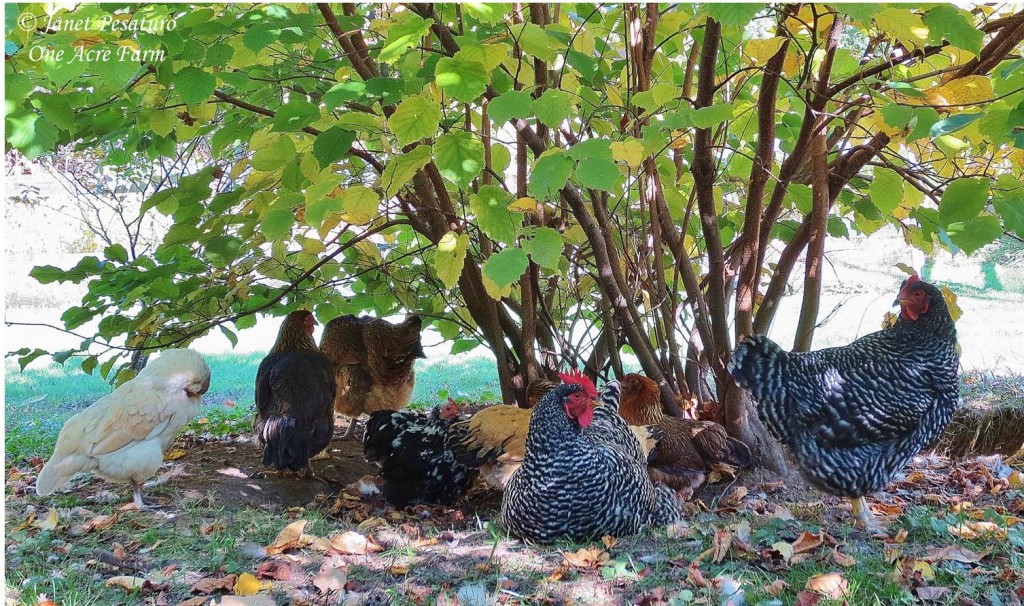
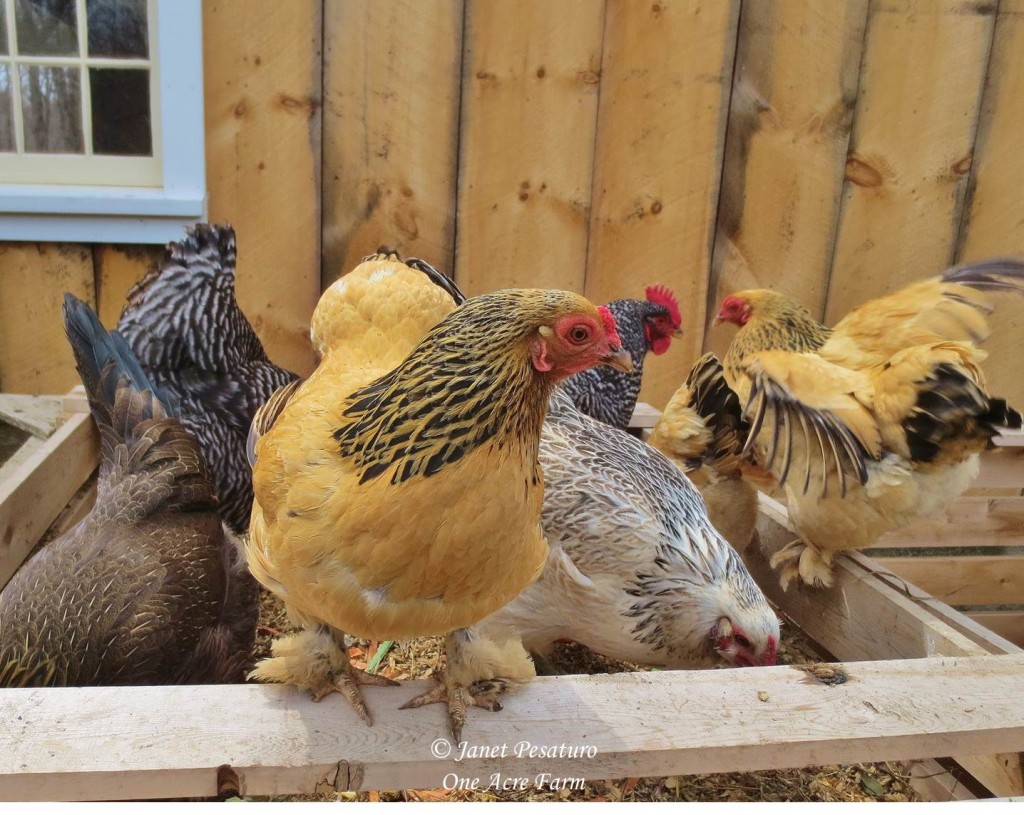
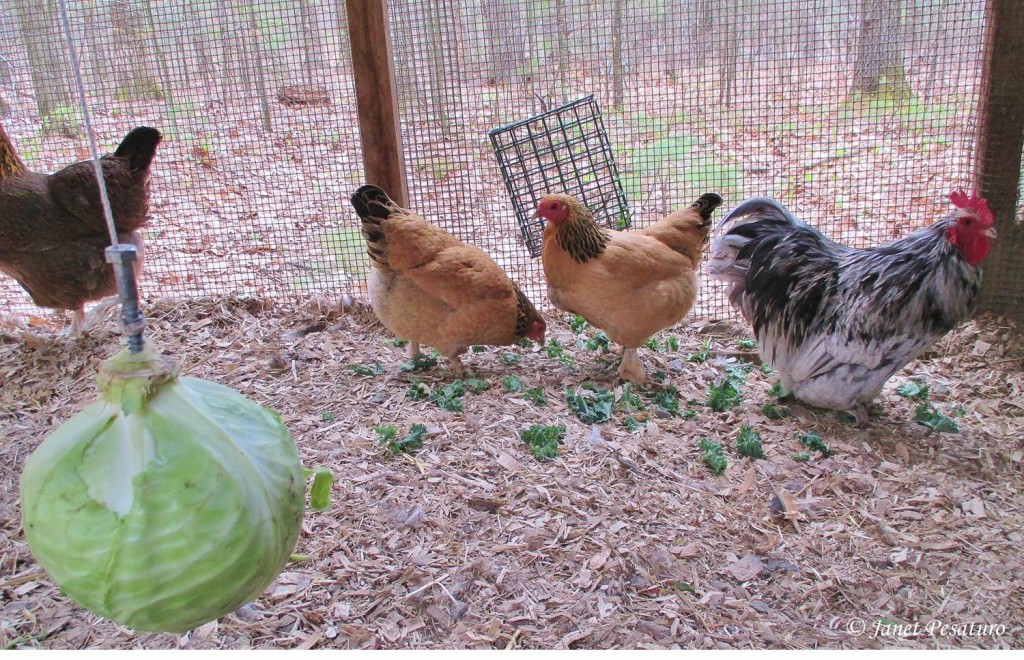
What a great resource you’ve put together here for those of us who wish to give our chickens the most satisfying and natural environment possible! I think it’s truly fascinating to observe my chickens acting like… well, chickens! They really do seem to appreciate plant diversity, and you’ve given some great ideas for enriching their environment, even with limited space.
Thanks so much, Rachel. I am really happy you stopped by because it led me to reading your most recent post…with which I totally identify!
Great info! I had no idea wild flocks were so small typically. I also try to mimic natural environments whenever possible. Our girls get plenty of time out of the coop and run as I shift electric netting paddocks around to fresh grass. They love being under our apple trees, especially in spring to eat bug larvae, and fall to clean up any fruit that we don’t get to in time.
Thanks for the cool post.
Glad you liked it. Yes, that’s what it’s about, mimicking natural environments. Really, it’s the same philosophy as permaculture, which you just posted about, except that the goal here is happy, healthy chickens rather than a balanced ecosystem. Nature truly got it right the first time. We humans are the ones who often get it wrong.
Love your article. We try and let our chickens free-range as much as possible and they LOVE it. I, too, provide branches from fallen trees for a chicken play area. : )
Glad you liked it. Sounds like you do a great job keeping your chickens happy!
Love this article about free range chickens. I have a question: do laying hens treated this way still need the expensive store-bought laying mash to produce eggs?
Very interesting question. I would say it depends. I doubt that plump, dual purpose or meat breeds would find enough food totally on their own no matter how good the habitat, but a slender, fast moving, good foraging breed free ranged in good quality habitat in warm weather might be able to get by with little to no supplementation.
However, we have bred them to lay a lot more eggs than wild jungle fowl (which lay a small number of eggs only in spring), so even slender breeds will have higher nutritional requirements, and I don’t know how successful they would do meeting those increased needs on their own. The fact that there are feral chickens in some tropical areas (like HI) says that some breeds can live with little to no supplementation, but I don’t know how well the hens lay, and the mortality rate might well be high.
Certainly in cold winter areas they need supplementation, because caloric needs are even higher, and there is little to no available forage. Jungle fowl are a tropical species and did not evolve to find food in conditions of snow cover.
The other thing to keep in mind is the risk of predation. Jungle fowl have evolved a certain coloration for good camouflage in their habitats, and certain behavioral traits that help them resist predators. Some important ones are strong flying, extreme wariness, and the ability to recognize the alarm calls of other species that share their habitat. Even so, I would guess that the predation rate is very high. Generally there is a very high mortality rate (perhaps about 50% per year?) in wild birds. Nature can tolerate that, but most chicken keepers cannot.
Because of all of that, I am no fan of complete free ranging. I keep mine fenced in a 1/4 – 1/3 acre yard, and try to create habitat complexity as well as I can.
I learned so much from this article and will use many of your ideas to make my flock happier and I’m sure, healthier. I also love raising chickens, gardening and trying to ‘homestead’ in an urban setting.
That’s great, Ruth, I am so glad this was helpful!
Thank you for some excellent ideas. We keep our chickens in the orchard, it keeps the pests down and they eat the windfalls
Sounds great, Mark! Our fenced in chicken yard is a mini orchard, with several fruit and nut trees and shrubs. They do love the fallen apples and pears.
Such great information, I learned so much! I was feeling sorry for my little flock that has dwindled down to 3 hens and 2 roos, but evidently it’s a good size. I do need to get rid of the younger roo though, the flock would be calmer without him. Thank you for sharing this at the HomeAcre Hop; I hope you’ll join us again this Thursday.
Kathi at Oak Hill Homestead
Thanks, Kathi. Yes, the biggest surprise to me in all the reading I did was the small flock size. Not mention the little gangs of roosters.
I had to read this twice, I was imagining kangaroos in with your hens!!!
Pingback: Simple Life Sunday Blog Hop | Cookes Frontier
Have a small flock, 4, 4 week old chicks. When should they be turned outside full time. They go out from 2-4 hours a day now\with supervision.
There’s no absolute answer to that, Rhonda. It depends on what predators live in your area, and what kind of risk you are willing to live with. Here, we have quite a variety of both aerial and land predators, so I let mine out for the afternoon only, while I am home. I have never allowed mine to completely free range full time.
It’s a shame you don’t have a donate button! I’d definitely donate to this fantastic blog!
I guess for now i’ll settle for book-marking and adding your RSS feed to my Google account.
I look forward to new updates and will talk about this site with my Facebook group.
Thanks, Tiffiny!
I grew up on a farm with chickens, but alas, I live in a housing association and chickens are not allowed. 🙁
That’s a bummer, Jonni, but thanks for stopping by!
This is a wonderful article.
Scale is the most important thing in chicken raising. Organic chickens that eat only grain and never venture out are a fraud. Might as well eat FF. So this advice makes my chickens and their eggs taste good enough to sell for gourmet prices and be a dinner better than ribeye steak at home.
I started out with absolutely superb chicken. But then I got too many (200) and I could taste the crowding in lesser quality and see their health decline a tad.
I have an acre and some overflow. I have to encourage my flock to use pasture and when I do they are in heaven. I have 10-12 pound Cornish cross that I use for breeding. Even they learn to love going long distances (200 yards off into the neighbors paste) to enjoy something special. If I feed the chickens lettuce and tomatoes they eat those but leave the apples and peppers. I make them eat those. They have learned to LOVE the roots of big old chard plants and such.
Yes, good point, scale is very important. Conditions do tend to deteriorate, the larger the population of any livestock species, imo. It’s probably true that cooped chickens who eat only commercial feed produce meat and eggs no better for us nutritionally than factory farm meat and eggs. But most backyard flocks, even if always cooped and fed commercial feed, have more space and freedom to move than factory farm birds, so still better than factory farm in my opinion. That said, I have certainly seen backyard chickens kept in deplorable conditions – filthy, crowded, and dark quarters, with dirty water and the same old food all the time. Hopefully, that’s the exception, rather than the rule. I do agree that they LOVE an outdoor environment where they can partake in a variety of plant and insect foods. Chicken heaven! Thanks for commenting, and for the compliment.
Pingback: Guide to Designing the Perfect Chicken Coop - One Acre Farm
Great article. It seems I have been doing many things right (more by accident than design) but I think there are a few suggestions that I can try from your article to make the girls that little bit happier! Thankyou!
Good luck with your hens, Irene, and thanks for stopping by.
i want to thank you for this invaluable information. I’ve been wanting chickens for over 2 years, researching for 18 months and will finally be building a chicken coop next month for 3-4 hens. Your site is the first to cover this aspect of raising chickens. I have 6 rather large privet trees I was going to chop down to make room for their run but now will be keeping them. They are home to hundreds of little birdies in Jan-Feb and thousands of bees all of March. The berries that drop are never ending and I believe will make a tasty treat for chickens. Great info! Keep up the very informative work. I will be following you for sure.
I am a label reading, repurposing, organic minded person, even when it comes to my pets. So researching chickens was very important to me. The space, city codes, neighbors thoughts, coop design predators, first aid, meals, treats, sanitation, I think I’m ready now.
I am so glad that this post was helpful to you, and it’s great to think that something I’ve written will maybe make the lives of some chickens a little better. Yes, I think your chickens will enjoy the shade, berries, and insects attracted to the trees. Best of luck with your new flock!
Pingback: Raising Backyard Chickens | PreparednessMama
This is a great article. What a treat! Thank you!
Glad you enjoyed i, Maizie. Thanks for stopping by!
Your article popped up on Pinterest today just when I had been looking for ideas for my lovely flock of 9 rescue girls. Lots of great tips that I can put into practice to make their life with me even happier than it has been so far. I volunteer with our Little Feathers Hen Rescue – very hard to resist bringing some home with me on rehoming days! Going to check out your other articles as I enjoyed this one so much. Thanks from a rather wet but Bonnie Scotland. 🙂
I’m so glad you enjoyed this post, Doreen. Lucky you, living in Scotland. We visited Scotland a couple of years ago – a vacation of a lifetime – what a gorgeous country!
We could do with a wee bit more sunshine and warm weather – not been very summery so far this year. I love my country very much – still many places I haven’t explored yet though. Where did you visit while over here? I live in a village just 5 miles north east of Dunfermline which was the ancient capital. While I was born and brought up in Scotland my much loved Mum was Cornish and my dear Dad was a Geordie ( from South Shields)..wonderful combination of independence celtic blood in my veins! LOL!
We stayed in Edinburgh for a week (after a week in London) and took several day trips around the country. We had to go to the usual touristy places, because we did not have a car and used tour buses. It was really wonderful, though, all of it beautiful.
Goodness, that must have been quite hectic! We live about 20 miles north of Edinburgh so can dip in easily. I like Edinburgh best just before Christmas when the castle is lit up and the trees along Princes St are decorated with pretty lights. Street vendors selling spicy hot snacks and there is magic in the air. 🙂
Yes, it was insane, quite a whirlwind. Next time I’d like to rent a car but stay for longer so we can get used to driving on the left side of the road, and take a more leisurely approach to exploring!
This is the best resource on keeping chickens ever! I am about to start building my chicken coop on my allotment and you have definitely given me some great ideas on the best way to do it. Thankyou so much.
Wow, that’s quite a compliment! Good luck with your chicken coop project, and thanks for commenting. Glad to be helpful!
Pingback: Limited Free Range Chickens: 12 Tips to Balance Freedom & Safety - One Acre Farm
Hi Janet, what a fabulous article you have put together. I’ve learnt so much and will put these great ideas into practice for my precious hens. I’m so glad I found this information, enjoy your farm,
Katrina
Thanks, Katrina, and good luck with your lucky hens!
We are just beginning to research having chickens, and we want to do it right. Your articles have really opened my eyes. My hubby is going to build a chicken coop this summer, and your helpful advice is duly noted and appreciated. We have coyotes, hawks, falcons and eagles to deal with! I always say, when you want to start a new project, pay attention to people who are doing it and take advantage of their knowledge. Thanks so much for your enlightening articles. 🙂
WOW!! I’m so glad to have found your place. The info on Red Jungle Fowl just confirms observations we have made here on our farm. We especially liked seeing that flocks have 1-2 subordinate roosters trailing as we see that here and always call them the “back-up” roosters to the main rooster because they will jump in to protect the hens if necessary. We also wondered when the roosters eat when they are free ranging as they are always on look out. Recently we noticed that the hens head back to the coop 1st and the roosters eat in a group with the “head” roosters eating 1st and the back-ups next, followed by the groups of younger roosters that have banded together. Of course they really don’t have to do this a we use GLD’s, Great Pryneese to watch the flocks. It’s just amazing that chickens have retained all these behaviors that “wild” chickens use. Thank you!!
CPL, it IS fascinating that they have retained some of these “wild” behaviors! I’m glad you enjoy observing them; as you can see, I do, too!
I really enjoyed your article!! All my life I have wanted land and finally, 2 1/2 years ago, my husband and I moved to a 13.8 acre farm which is mostly wooded. For years I have also wanted chickens but our neighborhood association wouldn’t agree and now we can have them. My husband is going to build a chicken coop and I want to get chicks next spring (I was thinking about 10 if you don’t think that’s too many). We will probably free range them part of the time since we have lots of brushy areas under trees and quite a few predators. Can you suggest other resources that would help us?
Can pigs eat autumnberriestoo?
Appreciating the hard work you put into your site and detailed
information you present. It’s good to come across a blog every once in a
while that isn’t the same old rehashed material. Wonderful
read! I’ve bookmarked your site and I’m adding your RSS feeds to
my Google account.
Pingback: Raising Baby Chicks Without A Hen: The First 6 Weeks -
Wonderful detailed information! We are planning to have 4/5 hens when we return to the Republic of Ireland in a couple of months and the above information will really help. Thank you.
Interesting article! I’ll refer to it once I get my chickens. I just finished the coop and run.
I was wondering what kind of chickens are in your pictures. They are beautiful! I’d like to get that kind.
Thanks for sharing your experience and knowledge.
Pingback: Exterior design insp – Typical Animation Student
Feed em fatten em eatem ??
Late comment, i know.
Loved this article so much!
I have only four bantams and have felt that this is too small a flock. I used to have more birds, but not too many. Even though for my part they could have produced more eggs (they are around five to seven years old) but they love to forarge. I haven’t done much in the garden as there is a slope covered in shrub (wild raspberry, which they jump up to pick) and the lawn is no lawn, but at mix of weeds, grasses and flowers.
We live in Moss, Norway. This «habitat» or really untidy backyard/ garden is good for the chickens. We have since moved outside the suburbs and live by the forests edge. Chicken house coming soon to the wilderness! Here we have foxes, probably badgers, even wolfs and lynxes in the next door municipality. On the island where we used to live (the chickens stay there with out sweet tenants until the new coop is ready) the only predators we had over the years was my brothers Boston terrier who jumped the fence to our garden and broke the neck of two young roosters, and an early morning fox who grabbed our beautiful buff dutch bantam Dolly. (My husband forgot to close the coop door and i was away, totally human error).
Now, at the forest edge, i must plan for a safe and Interesting habitat for them. Sadly we do not have jungel, but rather norwegian spruce and pine, with some birches in the mix. The plot itself is cleared of forest, to allow more light. There is much to do! We will plant Meadow flowers and mixed grasses, as well as insect habitats. ?????
I don’t know if you’re still answering questions. I enjoyed your article. We live in Utah. We have 11 hens but only laying 7 ~ 8 eggs a day. How do you figure which of the hens are not laying?♀️?♀️?♀️ ~ also it’s it common for them to lay in several of the same boxes when there’s enough for them to in their own boxes. Thank you for your article❣️
I’ve found that hens either love to lay in the same nest or prefer to hide their eggs if they can. If one of the hens goes broody, a lot of hens will lay right beside the broody hen and walk away! The broody girl will roll those eggs right underneath her! A problem if she’s already got her own clutch as there’s no way to see which ones need to be taken out. I mark the eggs that are already developing with a pencil mark…not felt pen!!…then just check every day and take out the ones with no pencil. Easy peasy.
Each hen does not necessarily lay an egg every day…also other things can affect egg laying… Such as stress from different sources..even heat! Short days in winter can affect egg laying as can molting season, which can vary with each darn chicken.